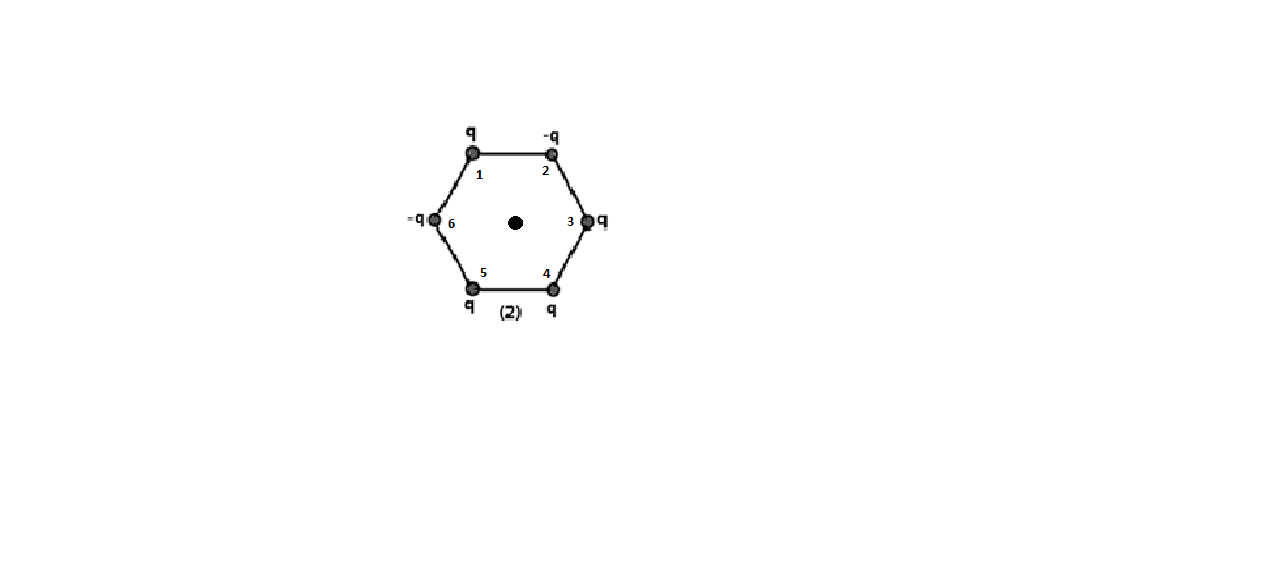
The figure below shows regular hexagons, with charges at the vertices. In which of the following cases the electric field at the center is not zero.

A) $4$
B) $3$
C) $1$
D) $2$
Answer
216.3k+ views
Hint: At the center of every hexagon, the electric field is zero. Here, the electric field will be zero because the charges of the same values with opposite charges will terminate each other i.e. \[{\text{ + q}}\] and \[{\text{ - q}}\] in each corner cancel out each other.
Complete step by step answer:
The charge at the position $1$ and the charge at the position $4$ cancel each other.
Whereas, the charges at positions $2$ , $5$ , and $3$ , $6$ will not cancel each other.

The magnitude of the electric field \[\left( E \right)\]occurred by a point charge with a charge of magnitude \[Q\] , at some distance $r$ away from the point charge, is given by the equation \[E = \dfrac{{k{\text{Q}}}}{{{r^2}}}\].
Where \[k = 8.99 \times {10^9}{\text{ N }}\dfrac{{{{\text{m}}^2}}}{{{c^2}}}\].
Hence, the right answer is in option $(D) \Rightarrow 2$ .
Additional information:
The electric field is outlined as the electric force per unit charge. The direction of the field is taken to be the direction of the force it might exert on a positive test charge. The electric field is radially outward from a positive charge and in toward a negative charge.
Note: Electric fields allow all things electrical to operate from the simple flashlight to the light switch you turn on when you enter a room and all the way on up to every single device using any form of electricity or Electronics including every computer, smartphone, radio, television, auto, airplane, and many medical advances.
Complete step by step answer:
The charge at the position $1$ and the charge at the position $4$ cancel each other.
Whereas, the charges at positions $2$ , $5$ , and $3$ , $6$ will not cancel each other.

The magnitude of the electric field \[\left( E \right)\]occurred by a point charge with a charge of magnitude \[Q\] , at some distance $r$ away from the point charge, is given by the equation \[E = \dfrac{{k{\text{Q}}}}{{{r^2}}}\].
Where \[k = 8.99 \times {10^9}{\text{ N }}\dfrac{{{{\text{m}}^2}}}{{{c^2}}}\].
Hence, the right answer is in option $(D) \Rightarrow 2$ .
Additional information:
The electric field is outlined as the electric force per unit charge. The direction of the field is taken to be the direction of the force it might exert on a positive test charge. The electric field is radially outward from a positive charge and in toward a negative charge.
Note: Electric fields allow all things electrical to operate from the simple flashlight to the light switch you turn on when you enter a room and all the way on up to every single device using any form of electricity or Electronics including every computer, smartphone, radio, television, auto, airplane, and many medical advances.
Recently Updated Pages
JEE Atomic Structure and Chemical Bonding important Concepts and Tips

JEE Amino Acids and Peptides Important Concepts and Tips for Exam Preparation

Electricity and Magnetism Explained: Key Concepts & Applications

Chemical Properties of Hydrogen - Important Concepts for JEE Exam Preparation

JEE Energetics Important Concepts and Tips for Exam Preparation

JEE Isolation, Preparation and Properties of Non-metals Important Concepts and Tips for Exam Preparation

Trending doubts
JEE Main 2026: Application Form Open, Exam Dates, Syllabus, Eligibility & Question Papers

JEE Main Correction Window 2026 Session 1 Dates Announced - Edit Form Details, Dates and Link

Derivation of Equation of Trajectory Explained for Students

Hybridisation in Chemistry – Concept, Types & Applications

Understanding the Angle of Deviation in a Prism

Understanding Collisions: Types and Examples for Students

Other Pages
JEE Advanced Marks vs Ranks 2025: Understanding Category-wise Qualifying Marks and Previous Year Cut-offs

How to Convert a Galvanometer into an Ammeter or Voltmeter

Atomic Structure: Definition, Models, and Examples

Ideal and Non-Ideal Solutions Explained for Class 12 Chemistry

Degree of Dissociation: Meaning, Formula, Calculation & Uses

Understanding Electromagnetic Waves and Their Importance




